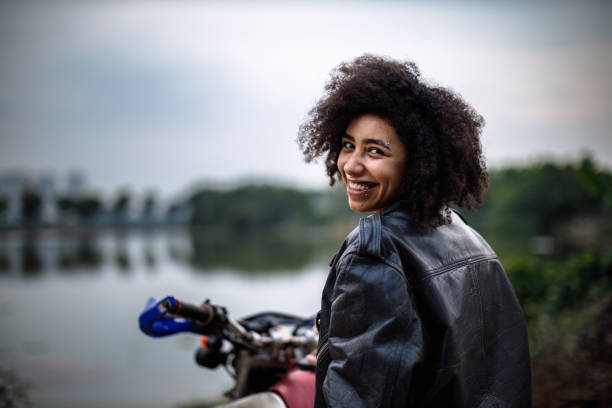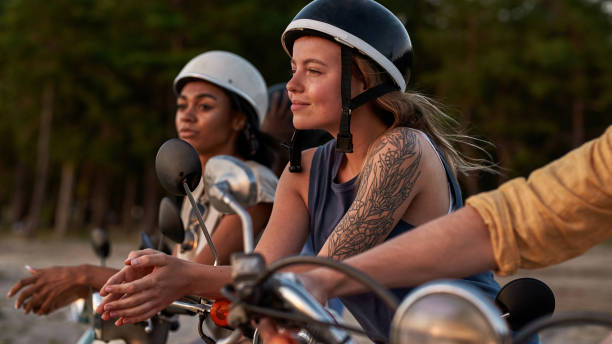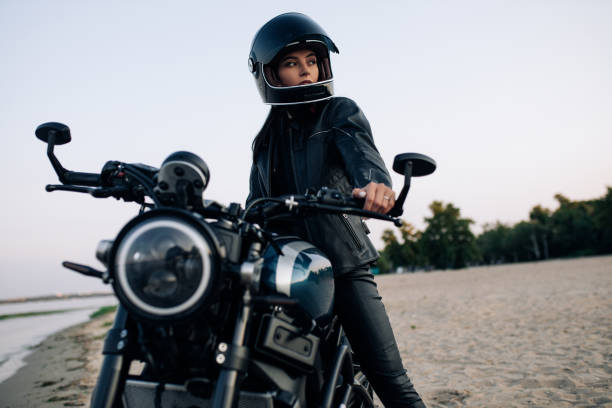Motorcycles, often seen as symbols of freedom and adventure, have attracted diverse enthusiasts from around the globe, including a significant number of women who have passionately embraced the motorcycle lifestyle. This article delves into the exciting world of women on motorcycles, highlighting celebrity female motorcyclists, the unique aspects of motorcycle life for lady riders, and the rich history of women motorcycle riders in the U.S.
The Rise of Women on Motorcycles
The journey of women on motorcycles in the U.S. is a tale of empowerment and breaking stereotypes. From the early 20th century, when motorcycles were seen purely as men’s vehicles, women have been steadily claiming their space in this exhilarating domain.
Historical Milestones
The journey of women on motorcycles in the U.S. has been marked by significant historical milestones that challenge traditional gender roles and promote inclusivity in motorcycling.
- 1915: Augusta and Adeline Van Buren, two pioneering sisters, embarked on a daring cross-country motorcycle journey, becoming the first women to ride across the continental United States. Their expedition not only showcased women’s capabilities in motorcycling but also sparked discussions about gender equality and adventure.
- 1930s: Dot Robinson, known as the “First Lady of Motorcycling,” emerged as a prominent figure in the motorcycling community. She not only competed in races but also co-founded the Motor Maids, the first women’s motorcycle club in the U.S. This club provided a platform for women riders to network, share experiences, and advocate for their place in a predominantly male-dominated sport.
Growth Over the Decades
The participation of women in motorcycling has experienced a steady growth trajectory, paralleling broader societal shifts towards inclusivity and empowerment.
- 1998: Women comprised approximately 8% of motorcycle owners in the United States, reflecting a relatively small but growing demographic within the motorcycling community.
- 2018: The landscape had notably evolved, with women making up about 19% of motorcycle owners in the U.S., according to data from the Motorcycle Industry Council. This increase signifies not only a rise in the number of female riders but also a cultural shift towards recognizing and celebrating diversity within motorcycling.
Celebrity Female Motorcyclists
Women on motorcycles aren’t just enthusiasts; many are also high-profile celebrities who have embraced the motorcycle lifestyle, serving as inspirations for both men and women alike. Notable Celebrity Riders include:
Pink
Pink, the pop star known for her powerful voice and energetic performances, is equally passionate about motorcycles. Her love for motorcycles is well-documented, and she is often seen riding and even performing stunts. Pink’s adventurous spirit and fearless attitude make her a true icon in the world of celebrity motorcyclists.
- Riding Style: Pink is known for her dynamic and fearless riding style, often pushing the limits and performing stunts.
- Motorcycle Collection: She owns a variety of motorcycles, showcasing her diverse taste and passion for different bike models.
- Public Appearances: Pink frequently appears at motorcycle events, showing her support for the motorcycling community.
- Advocacy: She advocates for more women to get involved in motorcycling, breaking stereotypes and encouraging female riders.
Angelina Jolie
Angelina Jolie, famous for her roles in action-packed movies, extends her on-screen persona to her real-life love for motorcycles. Jolie has been spotted riding motorcycles off-screen, demonstrating her passion for the motorcycle lifestyle. Her choice of motorcycles reflects her bold and adventurous nature, inspiring many fans around the globe.
- Riding Style: Jolie prefers sleek, powerful motorcycles that match her bold personality.
- Motorcycle Preferences: She is often seen riding high-performance bikes, reflecting her adventurous spirit.
- Off-Screen Riding: Jolie’s off-screen riding habits show her genuine love for motorcycles beyond her movie roles.
- Inspiration: As a high-profile celebrity, she inspires many women to explore motorcycling, breaking traditional gender roles.
Motorcycle Life for Lady Riders

Women motorcyclists navigate a distinct landscape characterized by both unique challenges and remarkable rewards.
Unique Challenges for Women Motorcyclists
Women on motorcycles often confront specific obstacles that can affect their riding experience. Understanding these challenges is crucial for fostering a more inclusive and supportive motorcycling community.
- Sizing and Availability of Gear: One of the most prominent challenges faced by women in motorcycling is finding gear that fits properly. The majority of motorcycle gear is often designed with male body proportions in mind, which can lead to ill-fitting and less effective protective gear for women. This lack of proper gear not only affects comfort but can also compromise safety.
- Societal Stereotypes: Women riders frequently face outdated stereotypes that question their capability or belittle their participation in what is often perceived as a male-dominated sport. These stereotypes can be discouraging and may deter women from participating fully in motorcycling activities or from pursuing advanced riding skills.
- Physical Demands: The physical demands of handling larger bikes, which are typically designed for the average male physique, can present significant challenges. This includes managing the bike’s weight and maneuvering it in various conditions, which can be particularly daunting for women who may have shorter stature or less physical strength relative to the designed user.
Unique Rewards of Motorcycle Riding for Women
Despite these challenges, the rewards of motorcycle riding for women are profound and often deeply personal.
- Strong Sense of Community: Many women riders find a supportive and empowering community among fellow motorcyclists. This community is not only a source of friendship and camaraderie but also serves as a valuable network for sharing resources, experiences, and encouragement.
- Empowerment: Mastering the skills to handle a motorcycle proficiently offers a significant sense of empowerment. The competence and independence gained through riding can impact all areas of life, boosting self-esteem and confidence.
- Freedom on the Open Road: The unparalleled sense of freedom experienced while riding is often cited as one of the most rewarding aspects of motorcycling. This freedom is not just physical but also psychological, providing a break from daily stresses and a chance for personal reflection.
Gear and Customization for Women Motorcyclists
To enhance safety, comfort, and personal expression, gear and customization play pivotal roles in the motorcycle life of lady riders.
- Gear: Advances in motorcycle apparel have led to more brands offering gear specifically designed for women, combining safety with style and comfort. This gear includes jackets, pants, gloves, and helmets that are not only protective but also aesthetically pleasing and comfortable for long rides.
- Customization: Women riders frequently customize their motorcycles to better fit their physical needs and aesthetic preferences. This can include adjustments to handlebars, seat heights, and suspension settings to improve handling and comfort. Additionally, many opt for custom paint jobs and accessories that reflect their personal style and make their bikes unique.
History of Women Motorcycle Riders in the U.S.

This section provides a detailed look at the evolution of women’s roles in the motorcycling community.
Early Advocates and Pioneers
The journey of women motorcycle riders began with bold pioneers who defied societal expectations to embrace the freedom and adventure of motorcycling. These early advocates not only challenged gender norms but also paved the way for future generations of women riders.
- 1920s to 1950s: Women began to make their presence known in motorcycling, often participating in races and long-distance rides, which were predominantly male domains at the time.
- Key Figures: Riders like Dot Robinson and Bessie Stringfield were instrumental during these early years. Robinson co-founded the Motor Maids, the first women’s motorcycling club in the U.S., in 1940, promoting safe riding and creating a supportive network for women motorcyclists.
Impact on the Motorcycle Industry
As more women take up riding, the motorcycle industry has evolved significantly to cater to this growing demographic. This shift has been marked by several key developments:
- Design and Marketing: Manufacturers and dealerships have increasingly recognized the importance of accommodating women riders in their designs and marketing strategies. This includes the production of motorcycles with adjustable ergonomics to suit different body types and more targeted marketing campaigns that appeal to women.
- Apparel and Accessories: The availability of motorcycle gear specifically designed for women has increased, focusing on safety, fit, and style.
Conclusion
Women on motorcycles in the U.S. represent a dynamic and growing community that challenges traditional norms and embraces the thrill of the ride. From the historical journeys of pioneering women to modern-day celebrity riders, the narrative of women on motorcycles is one of courage, community, and continuous growth. As more women gear up and hit the road, the landscape of American motorcycling is forever changed, offering a more inclusive and diverse environment for all enthusiasts.
This exploration into the world of women on motorcycles reveals a compelling story of progress and passion, where the roar of engines and the freedom of the open road are enjoyed by an increasingly diverse group of riders.
FAQ
For beginners, motorcycles like the Honda Rebel 500 or the Yamaha MT-03 are often recommended due to their lighter weight, manageable power, and comfort.
Look for local chapters of national organizations like the Motor Maids or the Litas. Social media and motorcycle dealerships are also good resources for finding community events.
Prioritize gear that offers protection and fits well. Check for adjustable features, adequate padding, and weather suitability.
Yes, many organizations offer women-only training courses that provide a supportive environment to learn riding skills.
